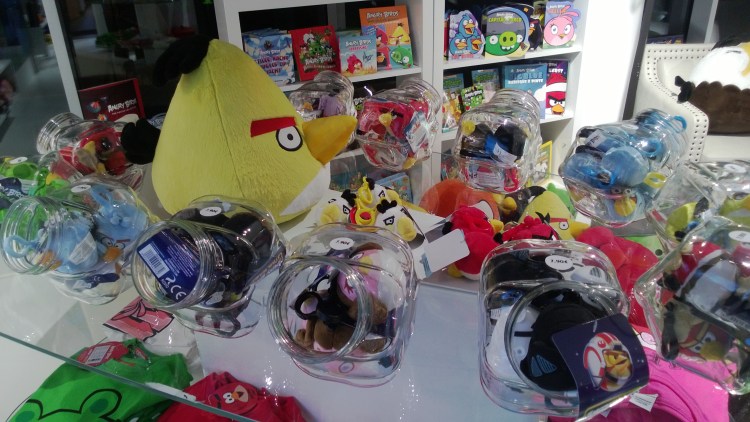Raising a big amount of money meant that investors like Accel’s Rich Wong recognized that Rovio wasn’t a one-game company. It was a one-brand company, and it could use that brand to create many releases — 11 based on Angry Birds so far — and leverage its strong financial position to either build or acquire new mobile brands.
Rovio has been an active acquirer, using its war chest to expand its ambitions in entertainment. In October 2011, the company acquired a Helsinki animation company. In March 2012, Rovio acquired Futuremark Game Studios. And in July 2012, it cut a deal with Activision to take Angry Birds to game consoles and handhelds.
It has also been busy with game launches. While Angry Birds debuted in late 2009, the company followed up with Angry Birds Rio, based on the 20th Century Fox animated movie Rio, in March 2011. Rovio then launched its Angry Birds Space game at the beginning of 2012 in concert with NASA, which launched the title from a space shuttle in orbit. That effort was the company’s first 360-degree launch, where it debuted the game, cartoon, apparel, toys, and books all at the same time.
With popularity at a high, Rovio tried to use its brand awareness to launch its first non-Angry Birds game in its modern era. In July 2012, it debuted Amazing Alex, another physics puzzle game, on multiple mobile platforms. Unfortunately, the game wasn’t the huge hit that others had come to expect.
In September 2012, the villains of Angry Birds got their own spin-off release, Bad Piggies, which chronicled the construction efforts of the pigs. That game reached No. 1 in three hours, compared to six months for the original Angry Birds. To keep the brand humming, the company released Angry Birds Star Wars in November 2012. During Christmas Day, 2012, the company saw 8 million downloads. During Christmas week, Rovio had 30 million downloads in a time where individuals activated 50 million mobile devices. And last October, the firm released Angry Birds Star Wars II.
“The key here is we are building a brand, and it can live through various channels of entertainment,” said Teemu Suila, chief operating officer at Rovio. “We are creating stickiness on top of the franchise. And we have a variety of different activities using the same brand and characters. The same machinery could be used to create new brands.”
In April 2013, Rovio reported its financial results. It generated $195 million in revenue in 2012, up 101 percent from $97 million in 2011. Earnings before interest, taxes, and depreciation were $98.5 million, up 50 percent from $60.2 million in 2011. During that year, Rovio doubled its headcount and set up a bunch of new offices. Licensed merchandise had become 45 percent of revenue.
But for much of 2013, a lot of talk focused on whether Angry Birds had lost its sizzle. John Riccitiello, former CEO of Electronic Arts, questioned whether mobile brands such as Angry Birds truly had legs. Would they still be around five years from now at the top of the charts? Rovio hasn’t been high in the top-grossing charts for some time.
In the first quarter of the year, Rovio still had 250 million monthly active users, and the company is able to partner with many of the biggest brands and businesses in the world. Those partners include Cheetos, Microsoft, Nokia, Mattel, and a variety of other companies. More than 500 Angry Birds licensees exist in 55 countries.
By contrast, Supercell, Rovio’s Helsinki-based neighbor, has become even hotter with Clash of Clans, which has held top-five slots in the top-grossing apps for more than a year. While rumors persisted that Rovio would go public, Japan’s SoftBank and GungHo Entertainment invested $1.53 billion in exchange for a 51 percent stake in Supercell, valuing Supercell at $3 billion. GungHo has now set up a deal to market Rovio games in Japan.
Surely this empire couldn’t fall apart? Antila points out that Hello Kitty has become a $9 billion business. With 800 employees, Rovio is busy making sure that it doesn’t fade out like a fad. It is publishing third-party games developed by other studios.
An Angry Birds Toons cartoon show has debuted on TV, and it had gotten 1 billion views in seven months. A total of 52 episodes should air. The company has created a playground in China and is creating a theme park in Spain.
The company’s latest effort is Angry Birds Go!, a mobile card game combined with figurines (using Hasbro’s Telepod technology) that will come out on Dec. 11. An Angry Birds movie, which Clay Kaytis (who worked on Disney’s Tangled animated film) and Fergal Reilly (who had involvement in the Cloudy with a Chance of Meatballs cartoon) are directing, still has a target release date of 2016. More things are coming, Rovio executives say.
Meanwhile, Rovio has spawned numerous spinoffs in Finland for new game companies. In a country with just 5 million people, Angry Birds has given Finns an enormous sense of pride, much like Nokia did in its heyday. Its success has inspired entrepreneurs, and the Finnish government points to Rovio as one of the reasons why it invests 500 million euros a year into research and development that includes startups.
For those startups, Suila advises, “Focus on making something unique and great. Then, get customers to love it.”
Vesterbacka says, “Love what you do, and success will follow.”
Check out our gallery of Rovio photos.
VentureBeat's mission is to be a digital town square for technical decision-makers to gain knowledge about transformative enterprise technology and transact. Learn More
















